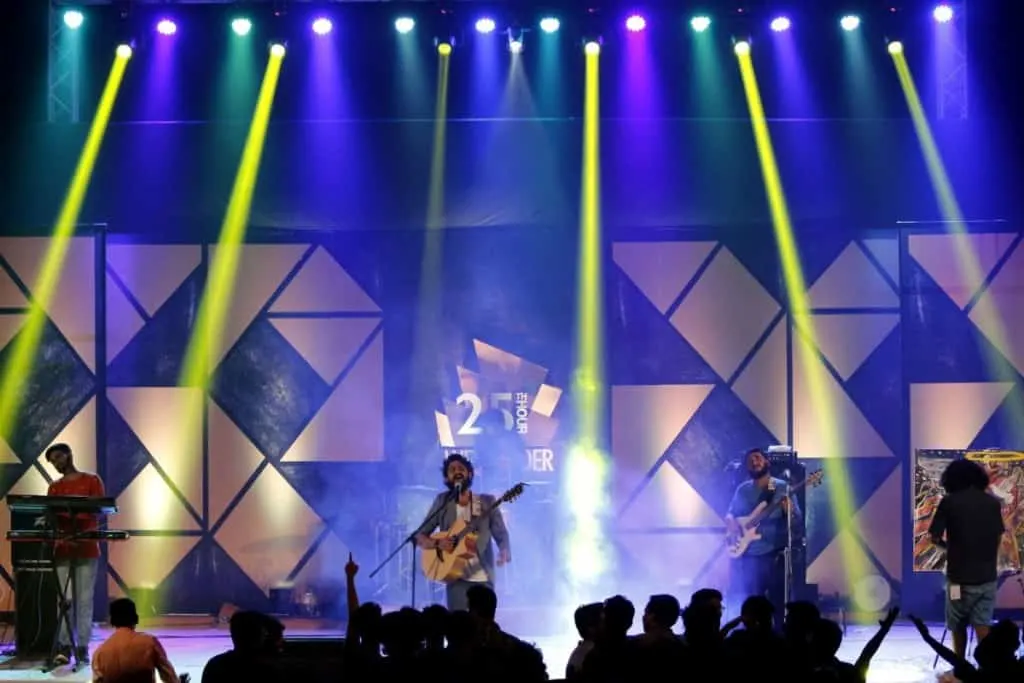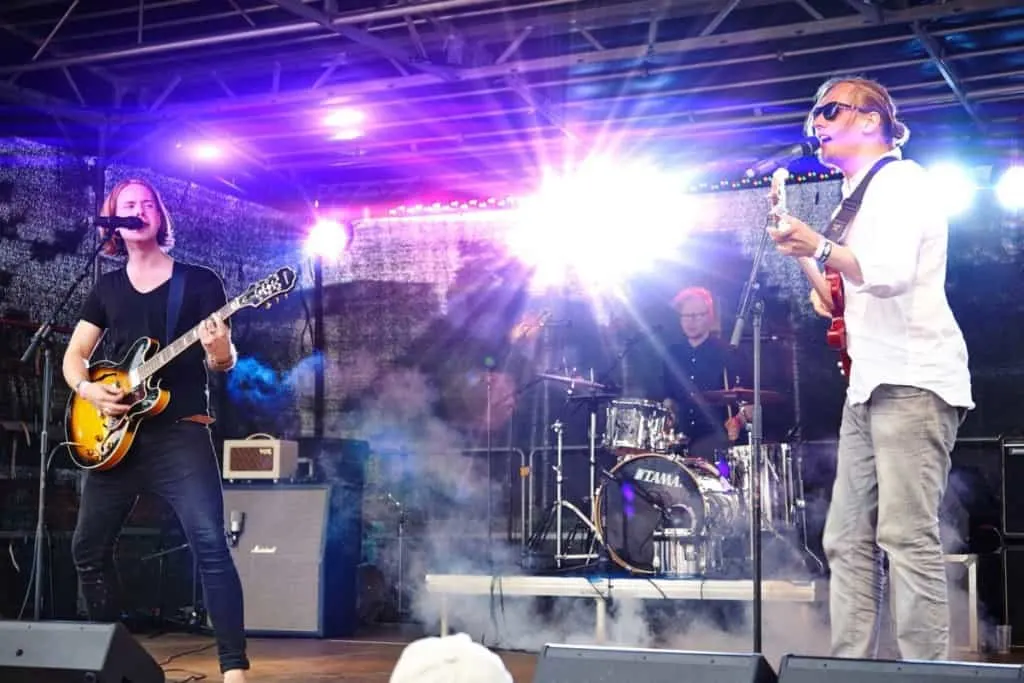I’m a firm believer that one should always start from the beginning.
Perhaps you always assumed you knew what an audio interface was and never took the time to really look it up. Well, this is to clear any doubts: an audio interface is an analog to digital and digital to analog converter.
An audio interface translates analog sound sources to digital so your computer can read them and then back to analog for a speaker to reproduce it.
It sounds very complicated, but most of them do it with zero latency, which means immediately.
Most manufacturers build upon that concept and add some other goodies that musicians love.
For example, it is common to find preamps on every input as well as multiple outputs, separate volume controls for headphones, and plenty of other features. Essentially, though, all of them build around the same concept.
Now, that being said, why would anyone need one of these outside of a recording studio? Well, I’ve worked as a live engineer for close to twenty years, and let me tell you that they have saved me more than once for sure. Let me tell you all about using an audio interface as an integral part of your live rig.

Why Use An Audio Interface In Live Performance
Nowadays there are many different scenarios in which you might need an audio interface.
What it all comes down to is the need to make digital sounds come out of an analog speaker and analog sounds going into software to modify them and turn them into something else.
Let me illustrate this with an example that I think is epic. Perhaps you are not familiar with him, but Trent Reznor is the leader, founder, and driving force of Nine Inch Nails; a band that pushed the boundaries of music technology since day one.
He’s played with artists the size of David Bowie, for example. In this cool video you can see him with two other legends: Josh Homme (Queens of the Stone Age) and Dave Grohl (do I need to write Foo Fighters/Nirvana/Them Crooked Vultures?). They got together for the filming of Dave Grohl’s Sound City movie.
In the clip, you can see a mix of old-school analog equipment, and halfway through you’ll notice Reznor plugging his guitar into a laptop to play through guitar software.
This is what many people do at home thinking it’s the next best thing after an amp. This guy does it as a way to bring down the mental walls we all have in our heads that tell us just how a guitar should sound. He’s got at his disposal some of the best amplifiers and recording gear money can buy but it is about creating a new landscape, getting to a new place.
- Introducing an audio interface to your live gear opens the door for the interconnection between the digital and the analog worlds.
Live VS Recording Audio Interfaces
Audio interfaces are normally found in recording studios. Most of us think of them in terms of how many inputs I can use to plug instruments and other sources to record them on our favorite DAW.
When you buy an audio interface thinking about your live performances, you have some other things to bear in mind; let’s take a look.
· Inputs And Outputs – This is a major difference between audio interfaces intended for studio and live purposes. In a studio situation, you need to hook up your studio monitors and a pair of headphones to the outputs and that’s about it. What you need to worry about is that the interface can translate many analog inputs into digital tracks in your DAW. When you use it for live performances, you tend to worry more about the outputs because that is what your interface will allow you to do. More on this later, but this is a major difference.
· Portability & Construction – Most studio environments are safe and hence, audio interfaces, don’t suffer much from the normal everyday wear and tear. On the other hand, audio interfaces made to play live need to be rugged; bullet-proof. Remember that they might be playing sounds through 10,000 watt PA systems blasting out inside an arena; they can’t be too fragile.
· Controls – Most of the time, the controls for an audio interface are on top or at the front and some times in the back. This is something to bear in mind when you are about to make the purchase because you might have to do some real-time adjustments to it and controls ought to be handy.
I have written an article on audio interfaces for beginners. You can read it here.

Different Venues, Different Stages
Most of us musicians tend to be road-proof to survive the times we live in.
Thus, you shall go with your performance through multiple different stages. Each of them in each venue will present a different challenge to overcome and entertain an audience. When you use an audio interface you can simplify a lot of the work for the sound engineer.
For example, coming out of a laptop from the headphones jack will give the soundman a stereo line that will very likely have a click on it that the drummer needs to follow.
How can you route it separately? Well, having multiple outputs on your audio interface does exactly that: you can route different instruments/parts to each output and hence they can crank that playback audio while your drummer follows the click in his ears alone.
Remember that performing live is all about creating magic in every moment and when you are comfortable playing and listening, you can concentrate on making that happen.
Drummers/Live Musicians
I wrote the title this way because the responsibility of triggering background sounds is mostly on the drummer’s hands.
It could very well be the guitar player, keyboardist, bass player or singer too.
The idea here is that this is a hybrid approach. This means that bands and musicians in this category go for analog and digital sounds on stage. Perhaps you play with a click and on top of that, you want to throw in some ambient noises and some background vocals for the singer to take off during the chorus. All of this is perfectly possible.
Another very common way to use this hybrid approach is using technology to modify sounds.
For example, as a guitar player, you can process the signal of your guitar on a program and then send it directly to the main mixing board (imagine not having to carry an amplifier ever again in your life!).
Finally, if you are a vocalist, you can add to your vocals that amazing autotune effect exactly the way you did it on the record because you can pull up the same session and just sing on that track. In fact, why stop there? You can do an entire show with backing tracks coming from the computer sending a click to your ears and the band mix to the PA.
There are a lot of different ways to do it that apply to different scenarios, let’s see how to route it properly.
How To Route An Audio Interface For Live Performance
The way to route an audio interface is different depending on what you are trying to accomplish.
For example, here is a cool video of how a drummer sets the session on Ableton Live and then triggers it from his chair. He explains how he mounted everything into a rack unit and is ready to go within minutes from arriving at the venue.
What you need to do is to plug everything you need to translate into digital to your audio interface.
Then, you could have several instruments grouped up and running through different outputs. If your audio interface features dual XLR outputs plus dual balanced TRS outputs you can send playback audio back to the console from the XLR and feed the monitor mixer with the click.
In this setup you’ll have two stereo, good sounding mixes to accommodate your band members and yourself.
Another option, for artists who blend guitars, vocals, and more with Ableton or any other software is to send their instrument straight to the mixing board and use the program and the audio interface to have a very reliable, good-sounding playback machine.
The better the quality of the DAC, the better it will sound.
A friend of mine, an audio engineer always said “if it sounds bad and you crank it, it sounds bad and loud”.
It’s like the pixels in a photograph, the better the definition of the camera, the more you can amplify it. In this case, the better the DAC, the more you can crank it without any unwanted noises. Here’s a cool video of a real-life musician explaining his setup involving an analog instrument (guitar), Ableton Live and a Scarlett interface.
Check out the amazing Focusrite Scarlett interface range here on Amazon.
I have written an article on why audio interfaces make a difference. You can read it here.
Electronic Music Artists
There are some artists who don’t use traditional analog instruments in the creation of their music but run everything through digital and MIDI. Do these artists benefit from using an audio interface in their live rig? The answer to that question is a firm yes.
MIDI and digital equipment are, by all means, incompatible with analog mixers, power amplifiers, and speakers.
There is no way on earth that a speaker is going to read zeros and ones. Hence, there has to be a translator in the room.
You could be a DJ using controllers, sample pads, and more to modify DAW settings in real-time. You could even have something like a drum machine at the core of your rig and utilize that MIDI clock to run everything else. Truth is that once the signal comes out of your rig, it has to be analog to be pumping out of those speakers.
- The best way to transform digital into analog is to use an audio interface.
In fact, the quality of that translation is what companies actually invest in.
When you are talking about an interface with several outputs and a good internal DAC, then you can handle all the sound-making from a laptop with controllers (MIDI keyboard, sample launchers, and such) and assign groups of instruments to each output.
This way you’ll be able to send all the bass frequencies divided to the subwoofers and the mids and the highs to the woofers and tweeters. Sending separated audio sources in small venues where the soundman might not have a good crossover can guarantee you’ll get the party started with that kick drum.

How To Route An Audio Interface To A Mixer
Going from your interface to the main sound mixer is very similar to the previous scenario.
The big difference here is that you will not be routing many more things other than your computer audio to the front of the stage. This simplifies the click problem but opens other question marks.
For example, can you route affected sounds to the front and dry signal to your monitors? Can you apply filters to the bass frequencies before sending them to the PA? Can you actually create two different mixes to have one for the audience and one for yourself?
I don’t mean to be a spoiler, but the answer to all those questions is yes as long as your audio interface has enough outputs.
For example, a model like the inexpensive Behringer U-Phoria UMC 404HD will give you enough flexibility to play anywhere you want.
It features four analog inputs with separate levels and a frontal headphone jack with its own separate volume knob. On the back, you have the dual XLR outputs to go to the PA without sound degradation, and two more stereo outputs for TRS cables as well as dual RCA outputs.
Route the different sounds and mixes to different outputs and enjoy floor monitoring as well as headphones and a perfectly clear and punchy sound from the front house PA.
Best Audio Interface For Live Performance
The market is vast and is filled with different models. In fact, every company will tell you that they solved your problem once and for all. Don’t worry because this post goes beyond marketing. These are my personal favorites; the ones I have tested in real-life situations and gave me what I paid for. Let’s take a look:
Apogee Duet
This Little wonder can very well fit the upper pocket of your shirt.
Don’t be fooled by its size, though, because it is responsible for many chart-topping hits across the world. The good thing about the Duet is that you have dual outputs and also a headphone output so you can do several routings with the tiniest apparatus.
But that is not the reason I picked it. The true reason behind my choice is that the DAC inside of it is among the best in the market. This tiny thing sounds incredible live, as well as in the studio. In this video, you can see it in action during a Maroon 5 show around minute 1:20.
Check out the Apogee Duet Here
This audio interface is ideal for all kinds of artists who need a simple, good-sounding audio interface to take on the road and use in any studio of the world.
Universal Audio Apollo Twin
Following the same route but going a little bigger, the Universal Audio Apollo Twin became a modern classic in very little time.
A great advantage shared with the Apogee is the ease of use with a single huge knob on top and some buttons. It features four outputs plus the frontal headphone jack allowing you to do all kinds of connections.
You can input two XLR cables and a Hi-Z instrument at once and have three different mixes going on at the same time. How’s that for flexibility!
Just like the previous case, the state of the art DAC and preamps in this audio interface will make everything sound much better at all times. With the Apollo Twin, you get flexibility and good sound in a small package that can fit your backpack or even the pocket of a big jacket.
Take a look at the incredible Apollo Twin here on Amazon.
MOTU Ultra-Lite AVB
MOTU is among the most named brands for live performing artists using audio interfaces.
Perhaps you haven’t heard about the brand, but it means the major leagues in terms of audio quality.
This particular unit is so rugged it seems ready to put your feet in Normandy during D-Day. Seriously, when MOTU says on the road performance, it really means it.
Check out the MOTU Ultra-Lite AVB range here on Amazon
This is an 18 inputs and 18 outputs audio interface featuring DSP mixing, AVB audio networking and can be controlled through Wi-Fi. It takes up only half a rack unit and is powerful enough to feed an entire band with sounds.
You can connect it using Ethernet on more complex schemes or to control lighting or video systems. It also features USB, Optical, and MIDI besides the stereo main outs, 6 analog outs, and headphone jack up front.
Again, the sound quality on all MOTU products is superb and if you need more flexibility than the previous two models, this is an amazing choice.

Final Words
The music-making world is always changing. Some people take on the change as a negative thing and you’ll hear them saying stuff about the golden era of music.
Others, like me, are always experimenting and reaching new plateaus trying to think outside the box. This is what an audio interface can do to your live rig: expand it infinitely.
Technology has come a long way in creating some of the most amazing pieces of gear for you to use. It is a privileged time to be a musician, go for it, and try to find your voice using whatever is within your reach. Always remember that there are no rules; and if there were, you should try to bend and break them to create something new.
Happy Playing!
